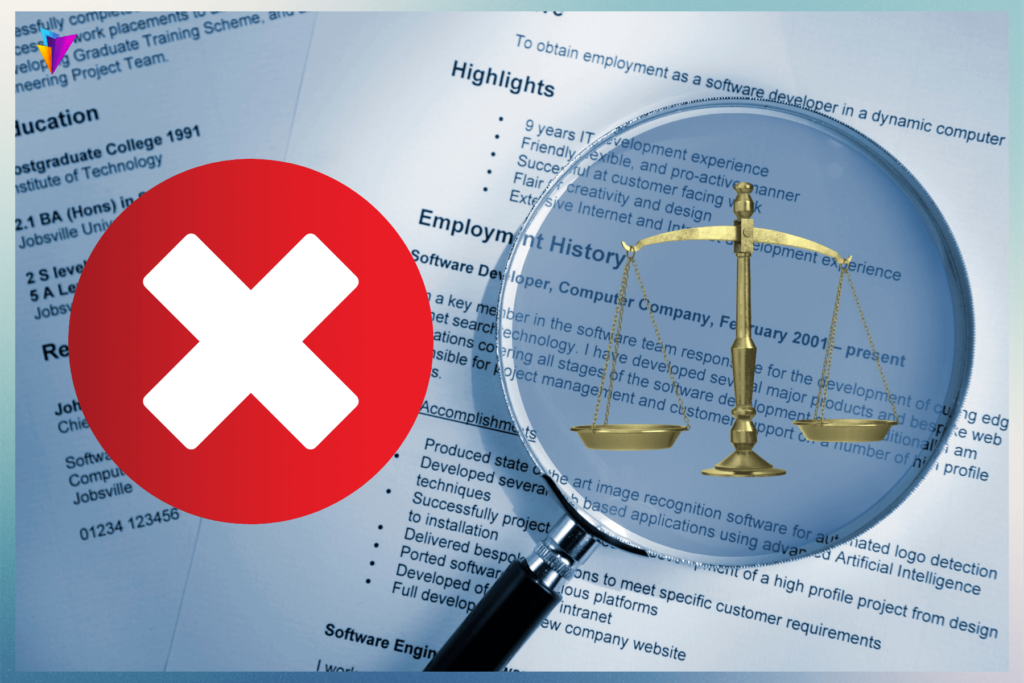Age bias, whether conscious or unconscious, remains a persistent challenge in recruitment, influencing how candidates are assessed based on their perceived age rather than their skills and experience. This bias affects both younger and older job seekers, leading to missed opportunities, workplace discrimination, and reduced diversity in hiring.
Understanding how age bias manifests in resumes, the impact it has on job seekers, and the steps that all organizations and companies can take to create a fairer, more dynamic, and more inclusive hiring process is critical to eliminating discrimination in recruitment.
How Age Bias is Identified in Resumes
Several elements in a resume can unintentionally reveal a candidate’s age or approximate age range, which may lead to age bias or age-related biases during the hiring process. Recognizing these elements and strategically managing them can help prevent discrimination and create an age-inclusive job market.
1. Graduation Dates
- Issue: Listing the year of graduation can disclose a candidate’s approximate age, leading to assumptions about experience level or career stage.
- Solution: Candidates can choose to omit graduation dates and instead focus on degrees earned, certifications, and relevant skills.
2. Extensive Work History
- Issue: Older candidates with long employment histories may face bias, as recruiters may perceive them as overqualified or too experienced.
- Solution: Instead of listing decades of experience, candidates should focus on their most relevant and recent roles.
- Tip: Using a summary format for earlier roles (e.g., “Previous experience includes leadership roles in XYZ industry”) can help avoid age-related assumptions.
3. Outdated Technologies and Skills
- Issue: Listing obsolete technologies, outdated programming languages, or legacy systems can signal that a candidate may not have kept up with industry trends.
- Solution: Candidates should highlight recent certifications, modern software proficiencies, and current industry-relevant skills.
- Tip: Ongoing professional development and recent training can demonstrate adaptability and learning agility.
4. Language and Phrasing
- Issue: Certain phrases can imply age-related stereotypes. For example, words like “seasoned professional” or “veteran in the field” may suggest an older candidate, while “digital native” may imply a younger candidate.
- Solution: Resumes should focus on quantifiable achievements, technical expertise, and leadership abilities rather than age-related descriptors.
Consequences of Age Bias for Younger and Older Candidates
Impact on Younger Candidates
- Perceived Lack of Experience:
- Hiring managers may assume younger candidates lack the skills or maturity to take on leadership roles.
- Even if they have relevant qualifications, they may struggle to advance into senior positions.
- Limited Opportunities for Senior Roles:
- Younger professionals may face skepticism regarding their leadership capabilities, even when they have the necessary competencies.
- Biases around maturity and decision-making can create barriers to career progression.
Impact on Older Candidates
- Stereotypes About Technological Adaptability:
- There is a common assumption that older professionals may struggle with new technologies, despite many being highly adaptable and experienced in industry-specific tools.
- Concerns About Longevity in the Role:
- Employers may worry that older employees are closer to retirement, making them hesitant to invest in hiring or training.
- Perceived Higher Salary Expectations:
- Hiring managers may assume that older candidates expect higher salaries due to their extensive experience, leading them to favor younger applicants who they perceive as more cost-effective hires.
5 Strategies to Reduce Age Bias in the Hiring Process
Organizations must take proactive steps to eliminate age bias in hiring. The following five strategies can help ensure a fair, inclusive, and unbiased recruitment process.
1. Implement Blind Recruitment Practices
Removing Age Indicators:
- Exclude age-related details such as graduation dates, years of experience beyond a certain threshold, or references to outdated skills.
- Focus recruitment on qualifications, competencies, and relevant expertise rather than perceived age.
Focusing on Skills and Achievements:
- Hiring teams should evaluate candidates based on demonstrated accomplishments, innovation, and adaptability rather than assumptions tied to age.
2. Establish Standardized Evaluation Criteria
Uniform Metrics:
- Implement structured hiring frameworks with predefined criteria to assess candidates.
- Use a score-based system to reduce subjectivity in resume evaluations.
Objective Scoring Systems:
- Define clear, measurable competency-based assessments to ensure all applicants are evaluated fairly.
- Reduce personal bias by focusing on performance-based indicators rather than perceived longevity in a role.
3. Provide Bias Training for Hiring Managers
Recognizing and Countering Age Bias:
- Conduct regular training sessions to help recruiters identify and address age-related assumptions.
- Raise awareness about unconscious bias and teach strategies to ensure equal consideration for candidates of all ages.
Promoting Workplace Diversity:
- Cultivate a culture of inclusion where age diversity is seen as an asset.
- Encourage cross-generational collaboration to leverage the strengths of all employees.
4. Use Inclusive Language in Job Descriptions
Neutral Terminology:
- Avoid age-biased language such as “seeking a young and energetic professional” or “looking for a seasoned expert.”
- Use skills-based descriptions to attract a diverse applicant pool.
Emphasizing Competency Over Tenure:
- Highlight required technical skills, leadership abilities, and problem-solving capabilities rather than experience measured in years.
5. Encourage Diverse Hiring Panels
Varied Perspectives in Hiring Decisions:
- Include interviewers of different age groups and backgrounds to create a balanced hiring panel.
- This reduces the likelihood of biased decision-making and promotes fairer assessments.
Balanced Decision-Making:
- You need to make sure that hiring decisions are not influenced by stereotypes and that every candidate is given an equal opportunity to compete for the role.
Conclusion: Building an Inclusive Workforce by Eliminating Age Bias
Addressing age bias in hiring is essential for fostering an inclusive, diverse, and high-performing workforce. By recognizing age-related indicators in resumes, understanding the consequences of age bias, and implementing structured, fair hiring processes, companies can create an environment where skills and qualifications—not age—determine hiring outcomes.
Employers that embrace age diversity benefit from:
- A broader range of expertise.
- Improved team collaboration.
- A stronger, more innovative workplace.
By adopting blind recruitment, standardized evaluations, bias training, inclusive job descriptions, and diverse hiring panels, organizations can ensure equal opportunities for candidates of all ages, ultimately enhancing both business success and workplace culture.










